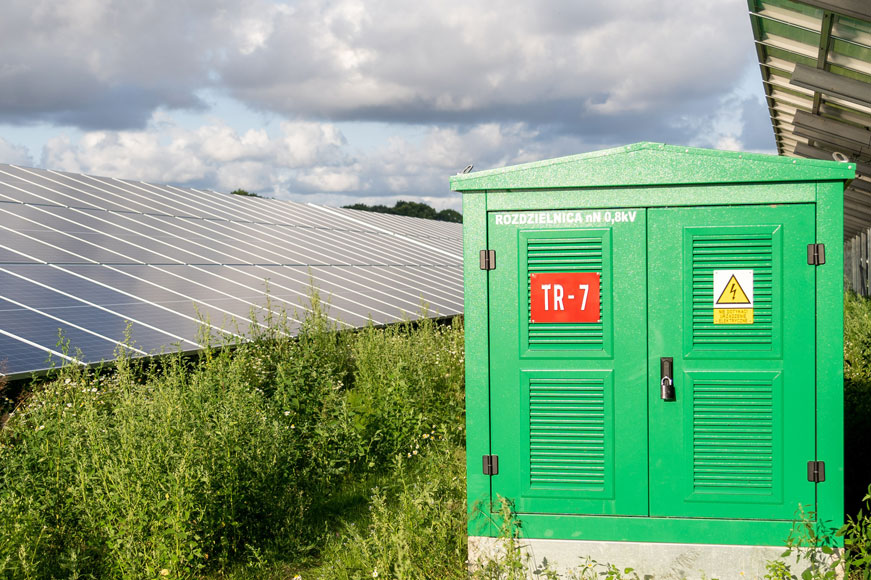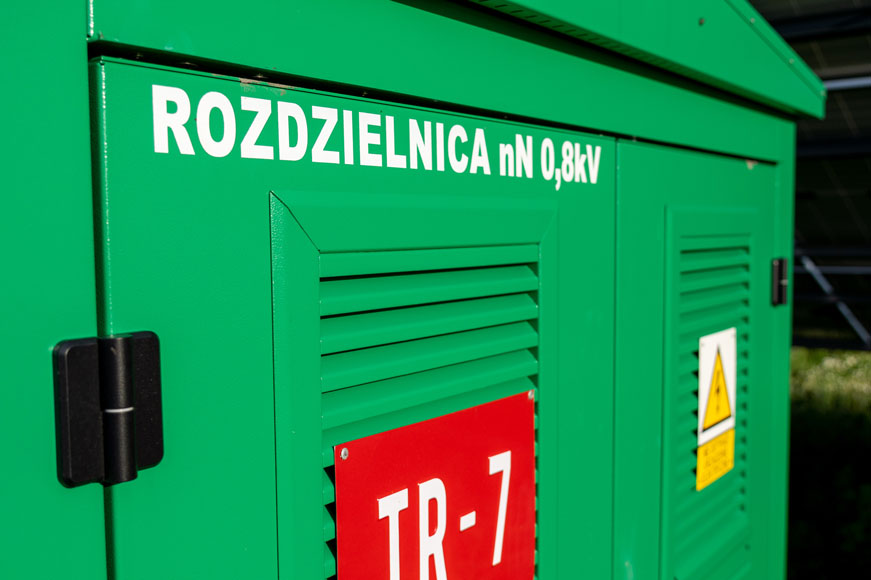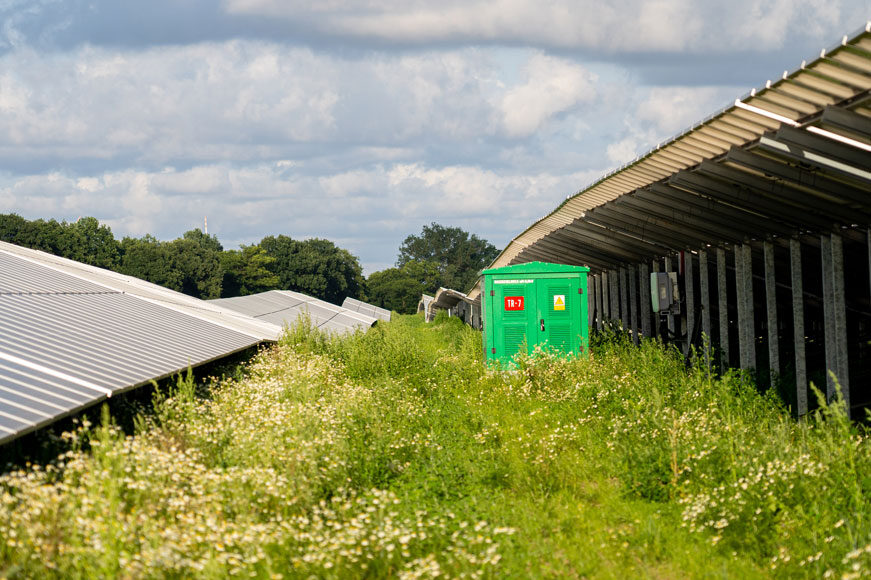They become smaller, lighter but have more power. ZPUE offers new solutions for the renewable energy sector.
Although fossil fuels still account for a significant proportion of the electricity produced, renewable energy sources are becoming a viable alternative to them.
ZPUE actively participates in the implementation of renewable energy installations, creating new solutions to serve RES. Changes and developments in this area concern transformer stations. In what direction is their modification going?
The last few years have been a turning point in the construction of containerised transformer stations. Before photovoltaics gained momentum on the market, the main customers for ZPUE’s substations were entities in the distribution power industry. Standard-compliant distribution stations are still in the portfolio of the Wloszczowa company, but the proportions have changed – in favour of equipping PV installations.
In the distribution power industry, loads were distributed between the morning hours when people left for work and the afternoon hours when they returned from work. The load was also different in houses and blocks of flats and different in industrial plants. In general, however, the energy demand did not exceed 50 or 60% of the substation’s rated capacity.
With renewable energy sources, on the other hand, transformers and other equipment work most intensively when the sun is shining or the wind is blowing. Often approaching and sometimes exceeding their rated output. When working with PV, there are several or sometimes more switchovers in the medium- and low-voltage switchgear during the day. This means a full load on the entire system.
Evolution instead of revolution
It became necessary to design transformer stations in such a way that they could operate with the greatest efficiency under the most difficult conditions. New models therefore began to appear on the market, including those with additional fans and ventilation louvres. Inverter manufacturers came to the conclusion that the capacities of the entire installations needed to be increased and raised the operating voltage of the equipment, doubling the efficiency of the inverters. PV installations thus moved from 400 to 800 V voltage, which motivated ZPUE to reconfigure the LV switchgear. An additional factor was changes to the network configuration, which reduced the number of cables or their cross-sections. The transformer station is one component of the PV installation, so it had to keep up with what the manufacturers of the other components were offering.
While only a year ago, stations adapted to the installation of 1 MW panels reigned supreme, from 2022 onwards, a trend towards a change in capacity can be seen and large-scale projects, i.e. above 2-3 MW, up to tens or hundreds of MW, have emerged.

Economy affects power
Up to now, the contracted capacity for photovoltaic installations up to 1 MW was the result of an auction system. It provided a subsidy, i.e. a guaranteed repurchase price for electricity for 15 years at a given price level. Therefore, such installations were built because they were economically justified. Unfortunately, in the last year energy prices have gone up significantly and the prices in the auction system have become too low. So building a 1 MW installation is no longer economically viable.
Large-scale installations have therefore started to be built because their costs in such an investment are, in effect, lower per installed capacity. This means a shorter payback time and energy being billed at market prices rather than through an auction system.
New requirements, new solutions
The high-capacity stations (up to 6-8 MW) are of a different design to existing stations. The transformer is located outside the station, in the open air under a canopy, which facilitates its cooling. This is because any enclosure restricts heat dissipation. And equipping these units with a forced ventilation system means additional costs, frequent maintenance and, ultimately, higher energy consumption.
A large-scale photovoltaic farm is usually a single electricity billing system. On the installation, which has a capacity of several tens of megawatts, slave-type receiving stations are distributed, i.e. without metering systems, only with built-in automation. These several-megawatt stations receive energy from the PV plant and transmit it to one central station – the Main Receiving Point (GPO). There, with full protection automation, metering takes place and overall energy accounting is carried out. The GPO stations terminate in power transformers that convert medium voltage to high voltage and from there the energy is fed into the high-voltage grid.
For now, apparatus and technological issues limit large-scale installations to 6-8 MW. All indications are that PV will move in this direction for the next few years. However, 1 MW stations have not been completely pushed out. It will still take some time to complete single-megawatt projects, for which orders are still coming in.
Solutions also for wind power
The growing demand for electricity, but also increasing environmental awareness, makes renewable energy, in particular that derived from wind power, one of the most rapidly growing energy industries globally in recent years. ZPUE also offers solutions for windmills.
There were no new wind power projects in Poland after 2016, so we mainly worked with this technology in the German market, where wind farms have existed for a long time and new ones are constantly being built.
A new trend has emerged in wind turbine installations: reactive power compensation stations.
Renewable energy installations producing energy from wind are generators connected to the electricity grid by cables. The nature of the off-take is different when the windmill is running and when its wings are not rotating. In such cases, there is little active power generation and reactive power is fed into the grid, causing a deterioration in grid parameters or voltage drops. Therefore, in order for the grid to operate efficiently, it is necessary to compensate for reactive power, i.e. to improve the parameters of the installation.
In new investments for wind farms, entire sets are ordered from ZPUE: the Main Receiving Point, oil pans and precisely the stations for reactive power compensation.
Demand for these devices is greater in the German market, as wind power is used on a large scale in that country. However, it can be expected that the emergence of orders for such reactive power compensation systems on the Polish market is a matter of short time .
The development of PV and wind power has led us to include bowls for power transformers, for which we have created specially designed moulds. A transformer needs oil in order to operate. However, an oil pan that captures its leakage in the event of damage or failure plays a protective role against possible environmental pollution.

Small, light, powerful
ZPUE has also recently been developing special stations designed for PV in a metal enclosure. They have a compact design and – particularly importantly – are low. And at the same time, they have a relatively high power output. These are stations that meet the requirements of sustainable development. They should stand, to use industry jargon, ‘under the table’, i.e. under the structure on which the PV panels are placed on PV farms. Behind one row of panels, without shading the next row. Thus, a small footprint was needed, while at the same time fulfilling the function of transmitting a large amount of power from a portion of the PV installation, the total capacity of which is even over 50 MW.
Each of these stations, measuring 3.4 x1.6m and 1.7m high, has a 1MW transformer inside, simplified MV and LV switchgear and the whole structure is set on a concrete foundation. It has the advantage of a compact metal structure, low height and low weight. It does not require multi-stage transport, complicated unloading or the construction of a special access road. It allows faster installation of the station at the target site.
Market trends. Advantages and disadvantages of products from the Far East
For large-scale PV farm installations, solutions from China have appeared on the European market. These are stations in metal containers, with capacities of 3, 6 and 9 MW. The whole is built into a single block measuring 6 x 2.5 m and 3 m high. However, the favourable price of these stations involves a bundled transaction, meaning that inverters and panels must also be purchased from the same manufacturer. An additional disadvantage of these solutions is their lack of adaptation to the requirements of the Polish market: there are no metering systems, no integrated foundations and the availability of spare parts is severely limited. In addition, they lack the normative confirmations required in Poland.
ZPUE has developed its own solution in this segment and is introducing it to the market. It is a station of more than 1 MW, in a metal casing, on a special frame, easy to transport and deliver directly to the site of PV installations both in Poland and Europe. In addition to the domestic market, Germany is already interested in this product from our factories, and the first stations will go there. France and Spain are also already asking for them.

